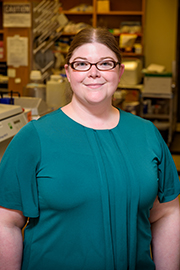Written by Hannah Buckelew
Mary Kathryn (M.K.) Sewell-Loftin, Ph.D., an assistant professor in the UAB Department of Biomedical Engineering, has been awarded a research grant from the UAB Division of Gynecologic Oncology for her project, titled, “Elucidating the Biomechanical Tumor Microenvironment of Ovarian Cancer.” This one-year, $50,000 award will examine how ovarian cancer cells respond to mechanical stimulation.
Mechanical forces play an important role in the development and progression of ovarian cancer, Sewell-Loftin explains, but little is known about how these forces specifically influence cancer cells to proliferate, migrate, and affect a response to chemotherapies. “We believe that these forces make the cancer cells more proliferative, more metastatic, and potentially more resistant to chemotherapies,” she says. “We’ll be studying this in a specialized 3D in vitro model that we refer to as microtissues.”
The project will focus on how ovarian cancer cells respond to their mechanical environment through a protein on the cancer cell surface called CD44 that has been shown to correlate with more severe ovarian cancer diagnoses. The team will observe how cells “feel” the mechanical strains through CD44 and how this influences the overall progression of ovarian cancer.
Sewell-Loftin’s study will investigate how mechanical forces present in ovarian cancers and enhance tumor progression. The research team will use engineering techniques to create systems to grow ovarian tumors in small tissue-like mimics, or microtissues, before subjecting them to mechanical forces similar to those that human tumors experience. In addition to the contained cancer cells, researchers will introfuce other cell types that contribute to the development of ovarian cancer such as fibroblasts, which play a role in tumor growth, and endothelial cells, which make up the blood vessels present in human tumors.
“A major benefit of this model over traditional mouse models is that we are able to use human cells to test basic cellular mechanisms,” says Sewell-Loftin.
Sewell-Loftin is hopeful the team will discover new methods to target and treat ovarian tumors through these studies.
